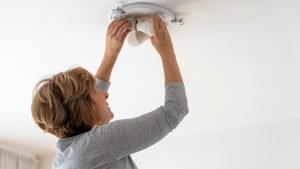
DIY home maintenance can be intimidating. Especially if you’re like me and don’t consider yourself a particularly “handy” person. But the truth is, some home maintenance tasks are actually pretty simple and with practice you can perform these yourself with ease and precision.
I’m not talking about major home remodeling, although if you want to take this on, more power to you! (I recommend getting a cost and safety consultation from a licensed professional.) I’m referring to one-off tasks that could help out in an emergency, save you money in the long run, and generally leave you feeling more empowered to care for one of your largest investments, your home.
Remember, these maintenance tasks should be simple to complete after you get the hang of it. If anything looks amiss always seek the assistance of a licensed professional. Now, roll up your sleeves and get ready to tackle these five home maintenance repairs yourself. You can definitely do this!
#1: Learn to Shut Off the Main Water Supply
Your main water valve controls the water supply for your entire home. While it’s unnecessary to adjust for an overflowing toilet (for that, turn the valve located directly behind the offending commode), controlling the main water supply can be necessary for emergencies.
If a pipe bursts, you experience a substantial leak, or there is sewage backup, shutting off the water to your home can help prevent major damages.
Tip: Do this once or twice before an emergency occurs to be sure you know exactly what to do if the need for speed arises.
The first step is to locate your water shutoff valve. The location is different for every home so this may require some detective work. If your home has a basement or crawl space, the main water shut off valve is likely located there, on a street-facing interior wall.
If you have a slab foundation, check near your hot water heater and/or inside your garage. In most cottage homes built on a chassis, like these homes at Simple Life, the main water shut off is located under the home, just behind a removable access panel in the skirting.
Once you’ve found your valve, simply hand turn it to shut off the flow of water to your home.
#2: Unclog a Sink or Drain
You’re probably already familiar with plunging a toilet to deal with a stopped-up sewer pipe. Try grabbing a plunger next time you have a clogged sink.
Make sure to hold the plunger so that it forms a tight seal around the clogged drain and if you have a double basin sink with two separate drains, experiment with plugging the free drain while you plunge the clogged one to keep the pressure sealed in.
#3: Replace Your Air Filters
Although this task sometimes gets overlooked because air filters are out of sight, replacing your air filters is a truly gratifying home maintenance task that can improve your home and your health.
Regular replacements, every 60 – 90 days, can increase the longevity of your heat and A/C unit, keep your home’s energy efficiency at a maximum, prevent mold, dust, and other allergy causing irritants from forming, and perhaps most importantly, greatly increase the quality of air circulating through your home.
Start by turning off your heat and A/C unit. (This prevents the unit from blowing dust and grit.) Next, open up your vent or panel and remove the used filter. If you’re installing a new filter, check the air flow arrows and make sure they are pointing toward the unit.
If you are re-installing the same filter remove dust and dirt by washing the filter with mild detergent and water making sure all the soap is rinsed away. Finally, install the new or clean filter, turn the unit on and breathe a fresh sigh of relief!
#4: Clean Your Dishwasher
93% of American household kitchens – even small ones – have a dishwasher. With regular use, it’s normal for food and grease to leave a residue inside the machine. That residue can eventually lead to dirty dishes and an unpleasant odor.
To prevent this, use a damp cloth to wipe the catch basin and around the filter of your dishwasher removing all debris. Then fill a dishwasher safe container with one cup of vinegar, place it on the upper rack of your machine and run a normal wash cycle.
#5: Replace Outlet Covers and Light Switch Plates
While outlet covers and light switch plates usually aren’t the cause for major disruption in your home, broken, dirty, or out-of-date covers can look dingy and can date your interior. To replace an outlet cover or light switch plate, simply unscrew the flathead screws that hold it in place. The cover or plate should come off easily when the screws are removed.
Holding the new cover in place with one hand, screw it securely onto the wall with the other. Be careful not to touch the screws or metal casing from the outlet with your hands or the screwdriver because the outlet is still live.
Tip! Match the color of outlet covers and light switch plates for a unified interior.
It’s time to take the handyman off speed dial and surprise yourself with your newfound skills and freedom! Try these simple home maintenance repairs to keep your home running smoothly.
Are you comfortable doing small maintenance checks and repairs in your home? If you are, what would you add to the list? How did you learn to do these? If you have never done home maintenance repairs, who does it for you?





